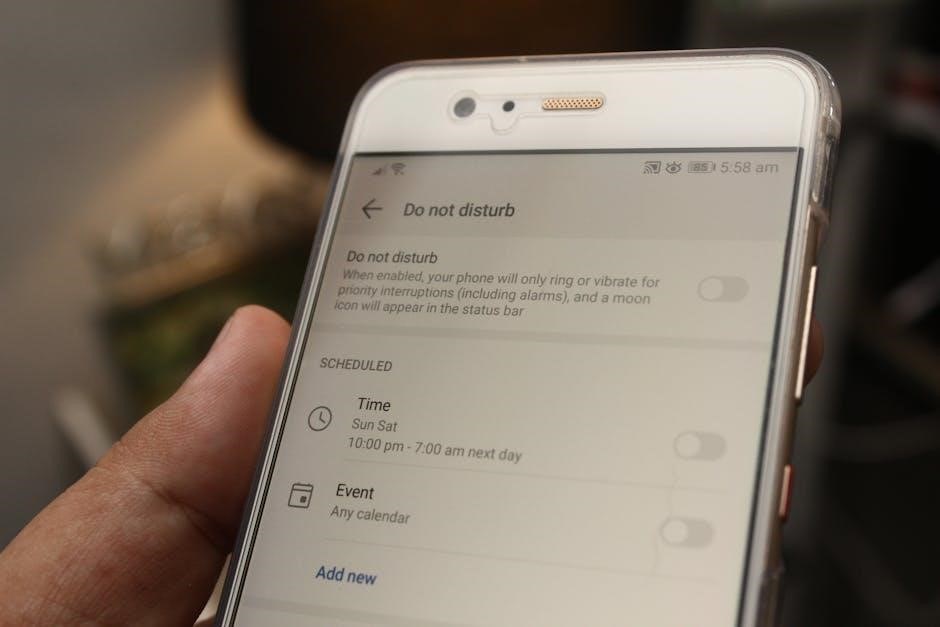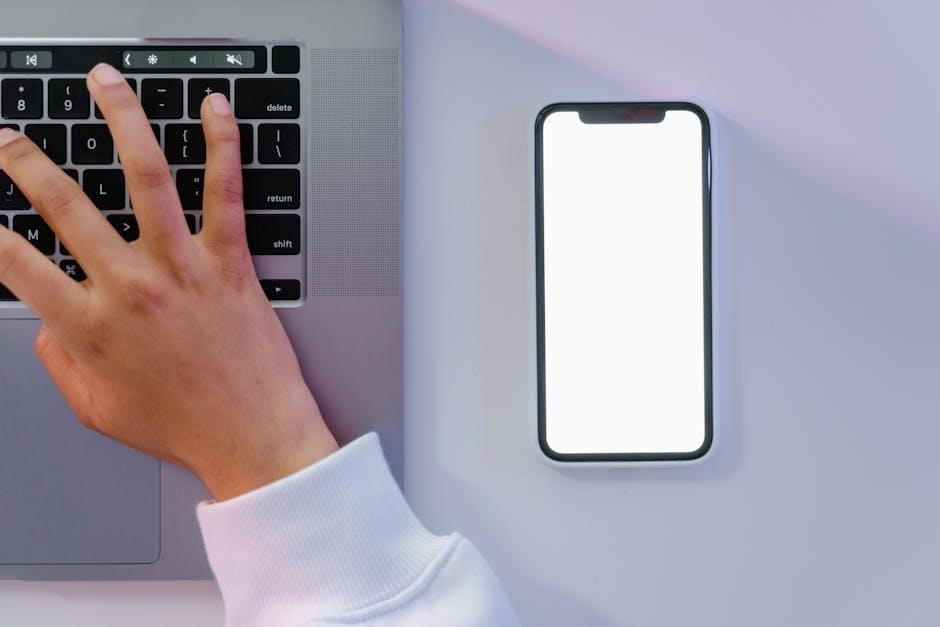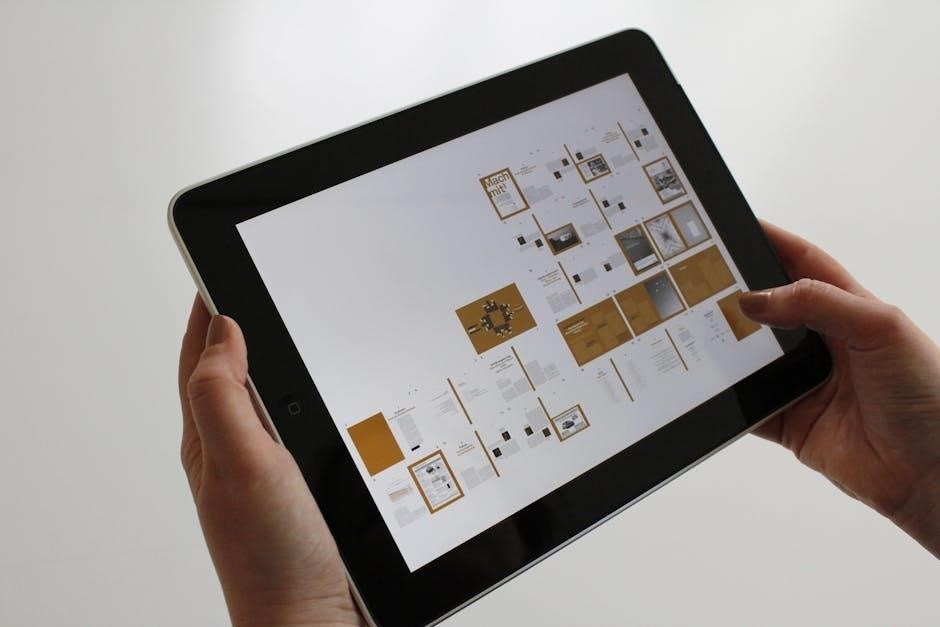nec phone user guide

NEC phones offer reliable communication solutions with advanced features and user-friendly designs․ This guide helps users understand and utilize their NEC phones effectively‚ ensuring optimal performance and functionality․
Overview of NEC Phone Systems
NEC phone systems‚ such as the DT300‚ DT410‚ and SV9100 series‚ provide flexible and scalable communication solutions․ These systems support advanced features like voicemail‚ call forwarding‚ and custom DESI labels․ Designed for both small and large businesses‚ NEC phones offer intuitive interfaces and robust functionality․ The user guide plays a crucial role in helping users navigate these systems‚ ensuring efficient setup and operation․ Whether it’s basic calling features or advanced configurations‚ NEC systems are tailored to meet diverse communication needs‚ making them a reliable choice for modern workplaces․
Importance of the NEC Phone User Guide
The NEC Phone User Guide is an essential resource for optimizing phone system functionality․ It provides detailed instructions for setup‚ configuration‚ and troubleshooting‚ ensuring users can fully utilize their NEC phones․ The guide covers basic operations‚ advanced features‚ and model-specific details‚ making it indispensable for both new and experienced users․ By following the guide‚ users can enhance productivity‚ resolve common issues‚ and customize their phone settings to meet specific needs‚ ensuring a seamless communication experience․
Key Features of NEC Phones
NEC phones are renowned for their advanced features and intuitive design‚ offering users a seamless communication experience․ They support essential functionalities like call management‚ voicemail‚ and call forwarding‚ ensuring efficient communication․ The phones also feature customizable options for ring tones and labels‚ allowing users to personalize their experience․ With robust integration capabilities and user-friendly interfaces‚ NEC phones are designed to enhance productivity and adapt to various business needs‚ making them a reliable choice for modern workplaces․

Telephone Layout and Components
Understand your NEC phone’s layout and components․ Familiarize yourself with the keypad‚ display‚ function keys‚ and ports for seamless operation and connectivity of peripherals;
Understanding the Phone Hardware
Your NEC phone consists of essential hardware components designed for optimal performance․ The base unit houses the main circuitry‚ while the handset includes a speaker and microphone․ The display screen‚ whether LCD or touchscreen‚ provides visual feedback and navigation․ Additional elements like the control panel‚ containing navigation keys and volume controls‚ enhance usability․ Ports for headset or USB connections are also included for flexibility․ These components work together to ensure reliable communication and advanced feature access․
Some models may include additional hardware‚ such as Bluetooth modules or expansion ports‚ depending on the specific phone series․ Always refer to your model-specific guide for detailed hardware information․
Handset‚ Call Indicator Lamp‚ and Exit Key
The handset is your primary tool for making and receiving calls‚ featuring a high-quality speaker and microphone for clear audio․ The Call Indicator Lamp‚ located above the handset‚ flashes to signal incoming calls or voicemails․ This visual cue ensures you never miss a call․ The Exit Key‚ typically marked with an arrow or “Exit” label‚ allows you to navigate back to the home screen or cancel a function․ These components are essential for efficient phone operation and are strategically placed for easy access․
Function Keys and Their Purposes
NEC phones feature programmable function keys that streamline call handling․ The Hold key places calls on hold‚ while Transfer allows redirecting calls to another extension․ Conference keys enable multi-party calls by adding participants․ Additional keys like Speed Dial and Call Forwarding can be customized for quick access to frequently used numbers or features․ These keys are typically labeled and can be programmed to suit individual or organizational needs‚ enhancing productivity and workflow efficiency․

Getting Started with Your NEC Phone

Unpack and connect your NEC phone‚ ensuring all cables are securely attached․ Power on the device and follow the on-screen prompts for basic setup․
Quick Telephone Tour
Your NEC phone features a sleek design with an intuitive interface․ Start by familiarizing yourself with the display screen‚ which shows call details and menu options․ Use the navigation keys to scroll through settings or select options․ The function buttons provide quick access to features like call forwarding or voicemail․ Explore the handset‚ base unit‚ and call indicator lamp for visual notifications․ Press the exit key to return to the home screen․ Connect your phone to power and network cables‚ then turn it on to begin setup․ Select your language and configure time/date settings․ Use the menu to explore advanced features and customize preferences․ This tour ensures smooth operation and quick access to essential functions;
Installing Custom DESI Labels
Custom DESI labels enhance functionality by providing clear button identifications․ Start by powering down your NEC phone to avoid any electrical issues․ Gently peel off the protective backing from the label and align it precisely over the corresponding button or key․ Press firmly to ensure proper adhesion․ Avoid touching the label surface to prevent fingerprints․ Use a credit card or similar tool to smooth out any air bubbles․ Once applied‚ power on your phone to test functionality․ This step ensures optimal usability and personalization for your NEC phone experience․
Basic Phone Setup and Configuration
Begin by connecting the phone to a power source and network․ Turn it on and follow the on-screen prompts for initial setup․ Access the admin menu using the default or assigned password․ Set the date‚ time‚ and timezone․ Configure network settings‚ such as IP address‚ subnet mask‚ and gateway․ Assign a unique extension number and set up voicemail access․ Customize ring tones and display settings as needed․ Save all changes before exiting․ This process ensures your NEC phone is ready for operation and integrated into your system․

Basic Calling Features
NEC phones offer essential call management tools‚ including making and receiving calls‚ placing calls on hold‚ transferring calls‚ and setting up conferences․ Use the phonebook and directory for quick contact access‚ ensuring efficient communication․
Making and Receiving Calls
Making calls on NEC phones is straightforward․ Lift the handset or press the speakerphone key‚ then dial the number using the keypad․ For receiving calls‚ the phone alerts you with a ringtone․ Answer by lifting the handset or pressing the speakerphone key․ Use the volume control to adjust the call volume․ If the call is on hold‚ press the corresponding line key to resume․ Ensure the phone is properly configured and connected to your network for seamless call management․ Refer to your NEC phone user guide for specific model instructions․
Call Management: Hold‚ Transfer‚ and Conference
Managing calls on NEC phones is efficient with features like Hold‚ Transfer‚ and Conference․ To place a call on hold‚ press the Hold key․ To transfer a call‚ press Transfer‚ dial the destination‚ and press Transfer again․ For conferences‚ press Conference‚ dial the participant’s number‚ and repeat for additional callers․ These tools enhance productivity and streamline communication․ Ensure proper setup and training for optimal use of these features․
Using the Phonebook and Directory
To access the Phonebook on your NEC phone‚ navigate to the main menu and select the “Phonebook” or “Contacts” option․ Here‚ you can add new contacts by entering their name and phone number‚ and edit existing ones to update information․ The Directory feature allows you to view and manage all stored contacts‚ typically organized alphabetically․ You can scroll through the list or search for specific names for quick access․ For additional functionality‚ check if your phone supports voice dialing‚ which may require initial setup․ To import or export contacts‚ refer to the user guide for instructions on using USB connections or software․ Deleting contacts is usually done by selecting the contact and choosing the “Delete” option․ For synchronization with other devices or platforms‚ consult the guide for details on syncing with computers or cloud storage․ Be aware of the Phonebook’s storage capacity to manage performance expectations․ Security features protect your contacts from unauthorized access․ Organize contacts into groups like “Work” or “Personal” for easier management․ Assign custom ringtones to contacts for personalized alerts․ Backup and restore options ensure your contacts are safe during device resets or transfers․ Utilize advanced search features to filter by name or company․ Customize display settings for better readability․ Explore these features step-by-step‚ and consult the user guide for any uncertainties․

Advanced Features of NEC Phones
NEC phones offer advanced features like video conferencing‚ call recording‚ and integration with CRM systems․ They also support app customization‚ programmable keys‚ and personalized alert settings for enhanced productivity․
Voicemail Setup and Management
To set up voicemail on your NEC phone‚ press the Voicemail key or dial the voicemail access code․ Follow the prompts to create a password and record a greeting․ You can manage messages by deleting‚ saving‚ or forwarding them using the navigation keys․ The phone also allows you to set up notifications for new messages via email or SMS․ Regularly check your voicemail to stay updated and ensure important messages are addressed promptly․
Call Forwarding and Do Not Disturb
Call Forwarding allows you to redirect incoming calls to another number or voicemail․ Press the Call Forward key‚ select the type of calls to forward (e․g․‚ all‚ busy‚ or unanswered)‚ and enter the destination number․ To deactivate‚ press the Call Forward key again․ Do Not Disturb (DND) mode silences your phone during specified times․ Enable DND via the DND key or through the phone’s settings․ You can customize DND to allow calls from specific numbers or forward calls to voicemail automatically․
Customizing Ring Tones and Alerts
NEC phones allow you to customize ring tones and alerts to suit your preferences․ You can select from a variety of preset tones or assign specific tones to individual contacts․ To customize‚ press the Menu key‚ navigate to Settings > Sounds‚ and choose your desired ring tone․ You can also enable or disable alerts for voicemail‚ missed calls‚ or system updates․ Additionally‚ the Alert Mode can be set to silent or vibration‚ ensuring minimal distractions while maintaining connectivity․

Troubleshooting Common Issues
Troubleshooting common issues on NEC phones involves identifying connection problems‚ resolving audio or display malfunctions‚ and restoring factory settings if needed․ Always check connections first․
Identifying and Resolving Connection Problems
Identifying connection issues on NEC phones starts with checking physical connections‚ such as ensuring cables are securely plugged in and not damaged․ Power cycle the phone by disconnecting and reconnecting the power source․ Verify network settings are correctly configured‚ including IP addresses and subnet masks․ If using a VoIP system‚ check for stable internet connectivity․ Restart the phone and test connectivity again․ If issues persist‚ consult the NEC phone user guide or contact technical support for further assistance․ Regularly updating firmware can also prevent recurring connection problems․
Fixing Audio and Display Issues
For audio issues‚ ensure the handset or speakerphone is properly connected and not muted․ Adjust volume settings using the Volume key․ Check for dust or debris in the handset or speaker grilles‚ which can cause poor sound quality․ For display problems‚ restart the phone and ensure brightness settings are adjusted․ Clean the screen gently with a soft cloth to remove smudges․ If the display remains dim or unresponsive‚ consult the NEC phone user guide for firmware updates or contact support for further troubleshooting․ These steps help restore optimal audio and visual functionality․
Restoring Factory Settings
To restore your NEC phone to factory settings‚ navigate to the Menu‚ select System Settings‚ and choose Factory Reset․ Enter the default password‚ typically 0000 or 1234․ Confirm the reset to erase all custom configurations․ The phone will restart with default settings․ After resetting‚ you’ll need to reconfigure your preferences․ Refer to the NEC phone user guide for detailed instructions and ensure all data is backed up before proceeding․ This process restores the phone to its original state‚ resolving persistent issues effectively․

Maintenance and Care
Regularly clean your NEC phone with a soft cloth and avoid harsh chemicals․ Update software periodically and handle the device with care to ensure longevity․ Professional servicing is recommended for complex issues․
- Clean the handset and keypad gently․
- Avoid exposing the phone to extreme temperatures․
- Use a protective cover to prevent scratches․
Cleaning and Sanitizing the Phone
Regular cleaning and sanitizing are essential to maintain your NEC phone’s performance and hygiene․ Turn off the phone before cleaning․ Use a soft‚ dry cloth to wipe down the handset‚ keypad‚ and display․ For tougher stains‚ lightly dampen the cloth with water‚ but avoid liquids contacting electrical components․ Sanitize using a 70% isopropyl alcohol solution on a cloth‚ carefully wiping surfaces․ Avoid harsh chemicals or abrasive materials that could damage the finish․ Regular cleaning prevents germ buildup and ensures optimal functionality and longevity of your NEC phone․
- Avoid direct sunlight or extreme heat during cleaning․
- Never submerge the phone in water or cleaning solutions․
Updating Firmware and Software
Regular firmware and software updates ensure your NEC phone operates with the latest features and security patches․ Access the NEC phone’s administration interface via a web browser to check for updates․ Download the latest version from the NEC website or through your system administrator․ Install updates during low-traffic hours to avoid interruptions․ After installation‚ reboot the phone to apply changes․ Always back up settings before updating to prevent data loss․ Keeping your phone updated guarantees optimal performance and compatibility with new technologies․
- Refer to the user manual for specific update instructions․
- Contact NEC support if you encounter issues during the process․
Best Practices for Longevity
To ensure your NEC phone lasts longer‚ clean it regularly with a soft cloth and avoid harsh chemicals․ Avoid exposing the device to extreme temperatures or moisture․ Handle the handset with care to prevent wear and tear․ Store the phone in a secure location when not in use․ Keep cables organized and avoid bending or pulling them excessively․ Use original chargers and avoid overcharging․ Restart your phone periodically to clear memory and maintain performance․ These practices will help extend the lifespan and maintain the functionality of your NEC phone․
- Avoid extreme temperatures and humidity․
- Use a soft cloth for cleaning․
- Store the phone securely when not in use․

Model-Specific Guides
NEC offers detailed guides for specific models like DT300‚ SV9100‚ and SL2100‚ providing tailored setup‚ feature customization‚ and troubleshooting tips for each device․
NEC DT300 Series User Guide
The NEC DT300 Series User Guide provides a comprehensive overview of the features‚ installation‚ and customization options for these advanced IP phones․ It covers basic setup‚ such as connecting the handset and configuring network settings‚ as well as advanced functionalities like call forwarding‚ voicemail‚ and conferencing․ The guide also includes troubleshooting tips for common issues like connectivity problems or audio interference․ Designed for both new and experienced users‚ it ensures seamless operation and maximizes productivity․ Specific to the DT300 Series‚ it highlights model-specific features and compatibility with NEC phone systems․
NEC SV9100 Phone System Guide
The NEC SV9100 Phone System Guide offers detailed instructions for configuring and operating the SV9100 series‚ designed for businesses requiring advanced communication solutions․ It covers installation‚ feature setup‚ and system administration‚ ensuring optimal performance․ The guide explains how to utilize key functionalities like call routing‚ voicemail‚ and mobile integration․ Additionally‚ it provides troubleshooting tips and best practices for maintaining system efficiency․ Tailored for IT administrators and users‚ it simplifies managing the SV9100’s robust capabilities‚ ensuring a seamless communication experience․
NEC SL2100 and SV8100 Differences
The NEC SL2100 and SV8100 are both advanced phone systems but cater to different business needs; The SL2100 is designed for scalability‚ supporting up to 1‚000 extensions‚ making it ideal for growing businesses․ In contrast‚ the SV8100 is better suited for small to medium-sized companies‚ offering a user-friendly interface and essential communication features․ The SL2100 also includes advanced features like DECT wireless integration and enhanced mobility solutions‚ while the SV8100 focuses on simplicity and reliability for everyday operations․ Understanding these differences helps businesses choose the right system for their specific requirements․

Additional Resources
Discover a wealth of support materials‚ including guides‚ troubleshooting tools‚ and contact options‚ to enhance your NEC phone experience and resolve any queries efficiently․
Downloading NEC Phone Manuals
NEC phone manuals are readily available online‚ offering detailed guidance for setup‚ troubleshooting‚ and feature utilization․ Visit the official NEC website or authorized dealers to download PDF versions of user guides tailored to specific models‚ such as the DT300‚ SV9100‚ or SL2100․ These manuals provide comprehensive instructions‚ ensuring users can maximize their phone’s functionality․ Regularly check for updated versions to access the latest features and improvements․ Downloading the manual is essential for optimal performance and ease of use․
Accessing Online Support and Help Desk
NEC provides comprehensive online support resources to assist users with their phone systems․ Visit the official NEC website to access the support portal‚ where you can find troubleshooting guides‚ FAQs‚ and detailed technical documentation․ The help desk is available to address specific issues‚ offering live chat or ticket-based support․ For immediate assistance‚ users can also contact NEC’s customer service team․ These resources ensure quick resolution of problems and optimal use of NEC phone features․
Additionally‚ NEC offers 24/7 support for critical issues‚ ensuring minimal downtime․ Users can also access multilingual support for convenience․ The online help desk is designed to provide personalized assistance‚ making it easier to navigate and resolve challenges efficiently․
NEC Phone Community Forums and FAQs
NEC phone users can engage with community forums to share experiences and resolve issues․ These forums are hosted by NEC and other third-party platforms‚ offering a space for discussions‚ troubleshooting‚ and tips․ FAQs (Frequently Asked Questions) sections are also available‚ addressing common queries about setup‚ features‚ and maintenance․ Users can search for solutions or ask questions‚ with responses from experienced users and experts․ This collaborative environment fosters problem-solving and enhances overall user satisfaction․
- Access forums via the NEC website or third-party platforms․
- Browse FAQs for quick answers to common questions․
- Engage with experts and peers for personalized support․



Leave a Reply
You must be logged in to post a comment.